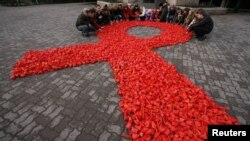Cambodia’s efforts to tackle HIV/AIDS over the past 15 years have won it praise, and put it well ahead of many other low-income countries. But some of those most involved in the fight against AIDS are worried that an array of challenges could see some of those gains undone.
For many years, Cambodia has relied on foreign donors to fund its largely successful fight against HIV/AIDS. In 2012, for example, 90 percent of the $50 million spent on combating the disease came from donors such as the Global Fund, the U.S. government and the Australian government.
Years of prevention, education and treatment have paid off: the rate of HIV-positive adults declined from 2 percent in 1998 to an estimated 0.7 percent, well ahead of its 2015 Millennium Development Goal target of 1 percent. The effort has been spearheaded by the National Center for HIV/AIDS, Dermatology and STD (NCHADS) the government body tasked with eliminating HIV.
The leader of NCHADS, Dr. Mean Chhivun, has an even more ambitious goal in mind. “So based on the experience we have in the past 15 years, based on the lessons we learned to fight against HIV and to provide better care to people who are living with HIV and AIDS, we set up a very ambitious goal to eliminate new HIV infection by 2020,” said Chhivun.
In Cambodia, HIV is mostly spread through heterosexual sex. The key at-risk population groups are the 36,000 or so entertainment workers, many of whom sell sex, as well as people who inject drugs, men who have sex with men, and transgender people.
Doing more with less
These high-risk groups can be difficult to find, so NCHADS and its partners have worked with civil society organizations that represent their interests. A year ago NCHADS rolled out a program offering finger-prick testing for HIV and counseling to the most at-risk populations. It currently reaches an estimated 40 percent of people in these groups; within a year, said Dr. Chhivun, it should reach 90 percent.
That’s all part of what Dr. Chhivun calls “doing more with less”, which has become increasingly important as donors slash funding. “So we have to identify the low-cost intervention but with high impact or good result. This is very important, you know, because we use our capacity that already built in the past 15 years to maintain our effort and also to maintain the coverage - this is the main challenge that we are facing in the future for the financial gap,” he stated.
But funding is just one part of the problem. Another issue is that key groups remain marginalized - some more than ever. Among those, said HACC, an umbrella group of around 120 NGOs and civil society organizations are the country’s 36,000 sex workers, nearly 15 percent of whom are HIV-positive; injecting drug users; and men who have sex with men.
More work ahead
Marie-Odile Emond, the country head for UNAIDS, said 83 percent of Cambodia’s 76,000 HIV-positive people now take antiretroviral drugs; and AIDS-related deaths declined 72 percent between 2005 and 2013.
But she said the at-risk groups are not getting enough help. Two pieces of legislation in recent years have made reaching these groups more difficult: a law to combat human trafficking, which also outlawed brothels, thereby driving much sex work underground; and legislation to improve security at the local level.
“And the impact of those laws has been really to lead a lot of those populations who are, you know, at risk for HIV - sex workers or drug users - to be afraid of being arrested and to then operate in a more hidden way,” explained Emond.
She said this is a serious concern that could undermine the effort to eliminate new infections.
The solution, at least in part, is for UNAIDS and others to retarget their efforts to make sure these groups know services are available. Cambodia, Emond said, is now “at a crossroads.”
“So it’s a very big funding change for the next few years, so we really hope that the government will increase the national funding because indeed all the investment made and the gains in the HIV response need to be sustained,” she stated.
To date it is the combined effort by government, the international community, civil society and the key at-risk population groups that has driven Cambodia’s success. But to meet its ambitious target of zero new HIV infections by 2020, the government will at the very least need to spend more and to ensure that different ministries pull in the same direction. So far, that is not happening.








